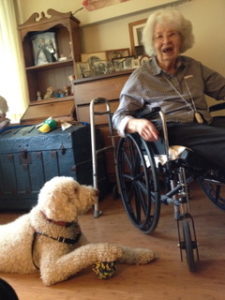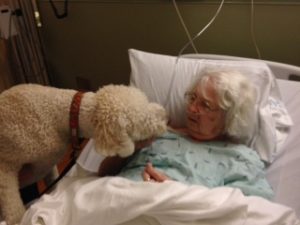Today SevenPonds is pleased to speak with Laurel Thom. Laurel and her Labradoodle, Homer, are a Pet Partners’ human-animal therapy team bringing comfort to the elderly and the ill. Pet Partners is an organization that facilitates animal-assisted interventions.
Editor’s note: This interview has been edited for length and readability. All photos of Homer courtesy of Laurel Thom.
 Melissa Gouty: What made you want to be a Pet Partners volunteer?
Melissa Gouty: What made you want to be a Pet Partners volunteer?
Laurel Thom: I have an aging grandmother, and she always perked up a lot when I visited her with Homer. After seeing that for a couple of years, I decided to go through the Pet Partners’ registration process.
Melissa: What can you tell me about your grandmother?
Laurel: She turns 104 in January. She was living independently until about nine years ago when she had some falls and needed a bit more care. Having Homer around has extended her life because she loves the dog and feels like the dog understands her in ways that people don’t. She’s in really good mental condition. She’s got mobility issues, but sometimes I’ll leave Homer with her and give her the responsibility to watch her for a couple of hours while I go to the movies or something. It’s just so stimulating and life-affirming for her to have a purpose: to watch the dog, sing to the dog and take care of her. Homer has been amazing with my grandmother.
Melissa: How do you get certified to be a Pet Partners’ therapy team? Is it tough?
Laurel: It is very rigorous. There is a course that you take either online or in person. There are two parts to the test. One part is the personality of the animal. Does it seem to enjoy being handled? Can it tolerate rough petting? Someone grabbing its ears, grabbing its feet? Really exuberant hugging?
The second part I would describe as “obedience.” There’s a series of 12 scenarios that they have you go through, such as basic commands like “sit,” “stay,” and “down.” The evaluators will drop something and leave it on the floor. They want to be sure that your dog does not lunge and pick something up because, in a hospital, it might be medicine or something that would be dangerous for your dog. They’ll expose your dogs to volunteers who use assistive devices like walkers or wheelchairs. They’ll drop something kind that makes a loud noise to see your dog’s startle response. They’ll stage an argument between volunteers, and then ask you to approach with your animal. They want to make sure that your dog doesn’t jump or growl or show any kind of aggression. They test for all sorts of things. If you get through all of that, you can become registered as a Pet Partners team.
Melissa: Are there people who try to do it and get turned away?

Homer
Laurel: There are. I know that from first-hand experience because the first time that Homer and I took the test, we did not pass. Towards the end of the exam, they bring in what they call a neutral dog. Homer was a puppy at the time, and you’re required to walk past the neutral dog and not have your animal try to greet the dog or vocalize toward the dog. Homer wanted to go play with the neutral dog.
Melissa: Neither one of my dogs could pass that test!
Laurel: It’s really difficult. The evaluators were really encouraging to me. They said, “You’re going to be a great team. Homer just needs to grow up a little more. You need to expose her to more situations and come back.” I did.
Melissa: You visit your Grandmother at her facility, but do you visit other people as well?
Laurel: Yes, I do. I work with Homer at a local skilled nursing facility called Baily-Boushay House. The treatment is such that about half of the clients have HIV and about half of them are there for complex care for illnesses like ALS, Huntington’s, MS or cancer. People come there for end-of-life care with some of those afflictions. Homer visits twice a month, and she visits an adult family home with primarily geriatric patients. She’s also about to start at a skilled-living facility.
Melissa: Is there an emotional toll on Homer?

Homer visits with
Laurel’s grandmother
Laurel: I would not describe it as hard emotionally just because I don’t know about her emotions. But I will tell you that it’s exhausting for her. Pet Partners limits any time that you visit two hours. At first, I thought, two hours, that’s not enough time, but there’s a reason Pet Partners has chosen it. Being exposed to that many different people and smells is very stimulating and in some ways stressful. Homer knows when she puts her vest on that I’m going to require perfect behavior. She watches me constantly to see what she’s supposed to do, and I think it’s draining for her.
Melissa: Is it draining for you as well?
Laurel: You know, it’s kind of energizing for me. I love being with Homer and seeing the good work that she does. We get tremendous positive feedback, so I’m always peppier when we leave our visits. She wants to come home, get a drink of water, and sleep for the rest of the day.
Melissa: Have you had any visits that are especially memorable?
Laurel: I’ve had lots of meaningful experiences, but I have two that stand out. One of our relationships was with a person who was at the end of life. He told me ahead of time that he didn’t think he was going to be around for much longer. I would always say to him, “But you’ll be here the next time I visit with Homer, right?” and he would always say, “Oh, yes. Not until after Homer comes the next time.” He just had such a good relationship with her. I know his days were dark, but when she walked into the room, he would just light up. He and Homer had a good visit the day before he died.
 For a couple of months after he died, no one occupied his former room. Homer always stopped and was pretty demanding that she go into that room. I would tell her, “He’s not in there anymore,” but it still smelled like him, so she would not let me walk by his room without checking to make sure that he was not there. That’s going to be one of the memories that sticks with me.
For a couple of months after he died, no one occupied his former room. Homer always stopped and was pretty demanding that she go into that room. I would tell her, “He’s not in there anymore,” but it still smelled like him, so she would not let me walk by his room without checking to make sure that he was not there. That’s going to be one of the memories that sticks with me.
The other one is fairly recent. There is a client who had been homeless. I met her maybe two-and-a-half years ago; she wasn’t in a facility at the time. I have trading cards with Homer’s picture on them that Homer carries in her little vest, and we give them out so people have a memory of the visit. I met up with this same client two-and-a-half years later and asked her if she wanted one of Homer’s cards. She said, “No. I have her card.” Despite all the things she’d been through while being homeless for more than two years, she had kept Homer’s card. It brought tears to my eyes. As difficult as it was for her to keep up with her possessions, that was something she held onto. That’s just what Homer meant to her.
Melissa: What do you think patients get out of the visits?
Laurel: Homer provides a change of pace in what is a fairly monotonous daily life. When clients see Homer they know it’s going to be a different sort of activity for them. I think they recognize that she is there unconditionally. They don’t need to give her anything. They don’t need to talk. They don’t need to do anything other than enjoy her.
 In thinking about this interview, I realized that because of the kind of facilities we volunteer at, our time is often a pretty quiet visit. I may ask a couple of questions, but basically, the client is quiet. Homer is quiet. They are just contemplative as they pet her. Sometimes her breathing slows down. Their breathing slows down. They are just in their own world. They can just be quiet and at peace with her. That’s what they get out of it.
In thinking about this interview, I realized that because of the kind of facilities we volunteer at, our time is often a pretty quiet visit. I may ask a couple of questions, but basically, the client is quiet. Homer is quiet. They are just contemplative as they pet her. Sometimes her breathing slows down. Their breathing slows down. They are just in their own world. They can just be quiet and at peace with her. That’s what they get out of it.
Melissa: What do you get out of your visits?
Laurel: My bond with my dog is so strong, and I enjoy spending time with her. I enjoy seeing her in the world doing good work. I am happy and proud and feel like she’s shining. Pet Partners will tell you that the facility personnel think that we’re there to visit the clients. But I can tell you that doctors, nurses, therapists, janitors, security guards and front desk receptionists — everyone in that facility — wants to see the dog when she comes in. We are doing good work for that staff who have such a difficult job as well as for the people who are living there. That’s a real treat for me, too.
Melissa: Thank you, Laurel. You do wonderful work. I’ve enjoyed hearing about Pet Partners’ therapy teams and the benefit they bring to people all over the nation.
If you’d like to learn more about Pet Partners, see our interview with Elisabeth Van Every, Director of Communications at Pet Partners.

 What is the Pet Partners Therapy Animal Program?
What is the Pet Partners Therapy Animal Program?


 Our Annual Seven Holiday Gifts for Someone Who Is Grieving, 2024 Edition
Our Annual Seven Holiday Gifts for Someone Who Is Grieving, 2024 Edition
 “Making Mobiles” by Karolina Merska
“Making Mobiles” by Karolina Merska
 “Hands Up to the Sky” by Michael Franti & Spearhead
“Hands Up to the Sky” by Michael Franti & Spearhead














